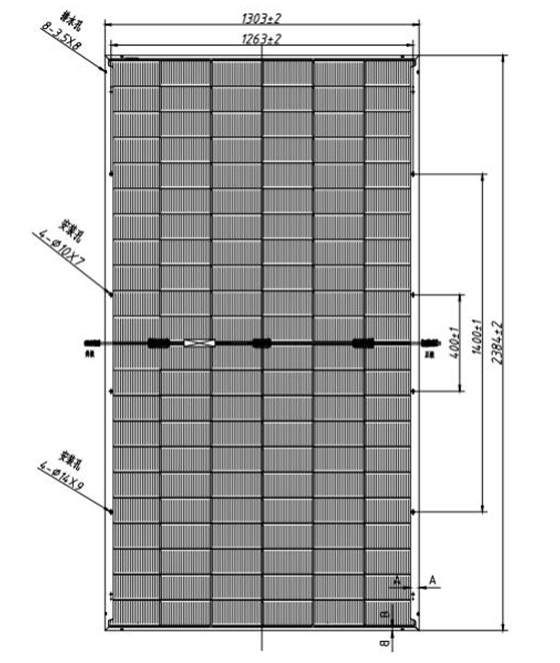 0
0
High Power Generation, Low LCOE
High-efficiency cell with advanced encapsulation technology
Industry-leading module output
Excellent power temperature coefficient -0.3%/℃

High Reliability
Cell lossless cutting+multi-busbar (MBB) /Super multi-busbar (SMBB)
Welding technology
Effectively avoid the risk of microcracks
Easily coping with various application scenarios

Maximum Power up to 730W
Module max output power up to 730W

Ultra-low LID
1% degradation in the first year, 0.4% annual degradation in the 2nd-30th year
Provide long-term and stable power generation revenue for end customers
Lower degradation with anti-PID cell and encapsulation materials
Maximum Power Output
Maximum Module Efficiency
Power Output Guarantee
Years performance warranty
Temperature Ratings
Nominal Operating Cell Temperature [NOCT] | 43±3℃ |
Temperature Coefficient ofIsc | +0.026%/℃ |
Temperature Coefficient of Voc | - 0.223%/℃ |
Temperature Coefficient of PMAX | - 0.243%/℃ |
Temperature Ratings
Operational Temperature | - 40~+85℃ |
Maximum System Voltage | 1500V DC-[H] |
Max Series Fuse Rating | 35A |
Electrical Specification [STC*]
Maximum Power | Pmax[W] | 690 | 695 | 700 | 705 | 710 | 715 | 720 | 725 | 730 |
Maximum Power Voltage | Vmp[W] | 42.82 | 43.02 | 43.21 | 43.40 | 43.59 | 43.78 | 43.96 | 44.14 | 44.32 |
Maximum Power Current | Imp[A] | 16.14 | 16.18 | 16.23 | 16.27 | 16.30 | 16.33 | 16.39 | 16.43 | 16.48 |
Open Circuit Voltage | Voc[V] | 49.04 | 49.10 | 49.17 | 49.24 | 49.30 | 49.37 | 49.44 | 49.51 | 49.58 |
Short Circuit Current | Isc[A] | 17.14 | 17.22 | 17.31 | 17.39 | 17.47 | 17.55 | 17.62 | 17.70 | 17.78 |
Module Efficiency | [%] | 22.30 | 22.50 | 22.70 | 22.90 | 23.10 | 23.30 | 23.50 | 23.70 | 23.90 |
Power Output Tolerance | [W] | 0~+3% | ||||||||
* Irradiance 1000W/m², Module Temperature 25℃, Air Mass 1.5
Electrical Specification [NOCT*]
Maximum Power | Pmax[W] | 534 | 538 | 542 | 546 | 550 | 554 | 558 | 562 | 566 |
Maximum Power Voltage | Vmp[W] | 38.54 | 38.73 | 38.91 | 39.10 | 39.29 | 39.49 | 39.67 | 39.86 | 40.05 |
Maximum Power Current | Imp[A] | 13.86 | 13.90 | 13.93 | 13.96 | 14.00 | 14.03 | 14.07 | 14.10 | 14.13 |
Open Circuit Voltage | Voc[V] | 45.68 | 45.75 | 45.82 | 45.89 | 45.96 | 46.03 | 46.10 | 46.17 | 46.24 |
Short Circuit Current | Isc[A] | 14.63 | 14.43 | 14.50 | 14.57 | 14.63 | 14.70 | 14.77 | 14.84 | 14.91 |
* Irradiance 800W/m², Ambient Temperature 20℃, Wind Speed 1m/s
Module Dimension

Mechanical Data
Number of Cells | 132 pieces [6×22] |
Dimensions of Module L*W*H{mm} | 2384×1303×35㎜ |
Weight{kg} | Approx 38.7 kg |
Front Side Glass | 2.0, Anti-reflection coating glass |
Back Side Glass | 2.0, Hightransparency solar glass |
Frame | Anodized aluminium |
J-Box | Protection level IP68 |
Cable | 4.0㎜², 300㎜ |
Number of diodes | 3 |
Wind/Snow Load | 2400 Pa/5400 pa* |
Connecto | MC4 compatible or MC compatible |
Faq
How big will the solar industry be?
The solar energy industry has experienced rapid growth over the past few decades and is likely to continue to experience strong growth in the coming years. This growth is mainly due to the increasing global demand for renewable and clean energy to address challenges such as climate change and energy security. Here are some predictions and trends regarding the size of the solar industry:
Global market size: According to a report by the International Energy Agency (IEA), solar power generation will become one of the most important sources of electricity in the next few decades. According to predictions, by 2030, solar energy will become the main source of new power capacity in the world, and by 2040, about one-third of the world's electricity will come from solar power generation.
What is the difference between monocrystalline and polycrystalline solar modules?
Monocrystalline solar modules are more efficient and space-saving, making them an ideal solution for residential and small commercial rooftop projects.
Polycrystalline solar module production conditions are less demanding than monocrystalline, making them a more economical and versatile choice. Polycrystalline modules are suitable for various application types, including off-grid and grid-connected projects, etc., especially for large ground power stations, with outstanding cost performance.
Why do we need solar energy?
As a renewable energy source, solar energy is of great significance in energy transition and environmental protection. It is important in many aspects:
Environmental sustainability: Solar energy is a clean energy source. The use of solar energy will not produce harmful gas emissions and will not cause pollution to the atmosphere and environment. It helps reduce dependence on fossil fuels, thereby lowering greenhouse gas emissions and mitigating the effects of global climate change.
Reduce energy consumption: The utilization of solar energy can reduce dependence on limited resources such as fossil fuels such as coal, natural gas and oil. This helps reduce the demand for energy, protect limited natural resources and provide a sustainable energy supply for the future.
Regional independence: Solar energy can be used in many places, especially in areas without easy access to traditional energy sources. This energy can provide power in rural, remote areas or areas without stable electricity supply, helping to improve the quality of life and promote the development of local economies.